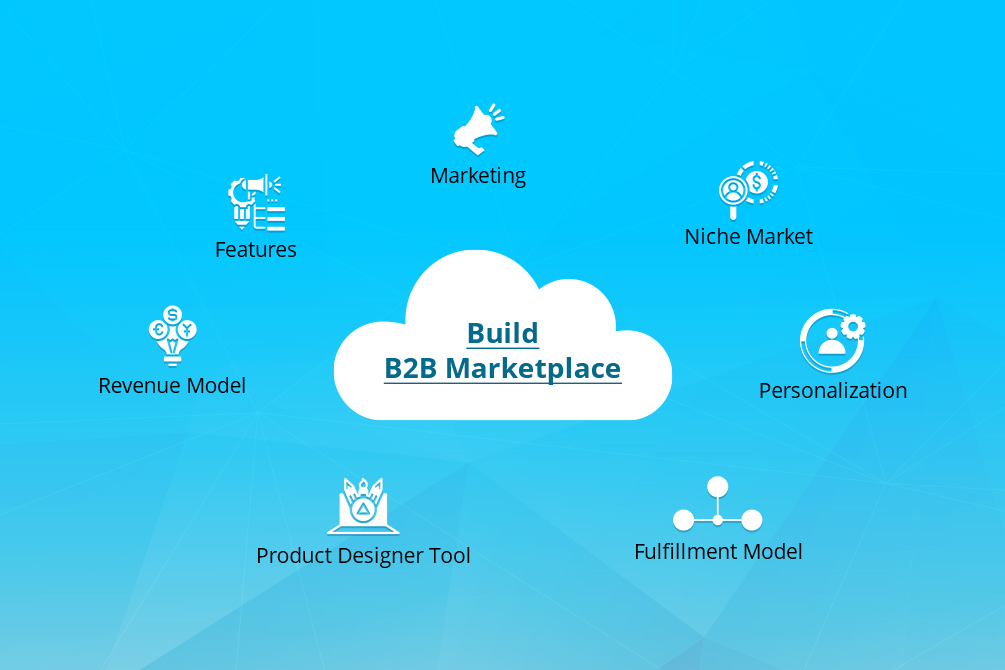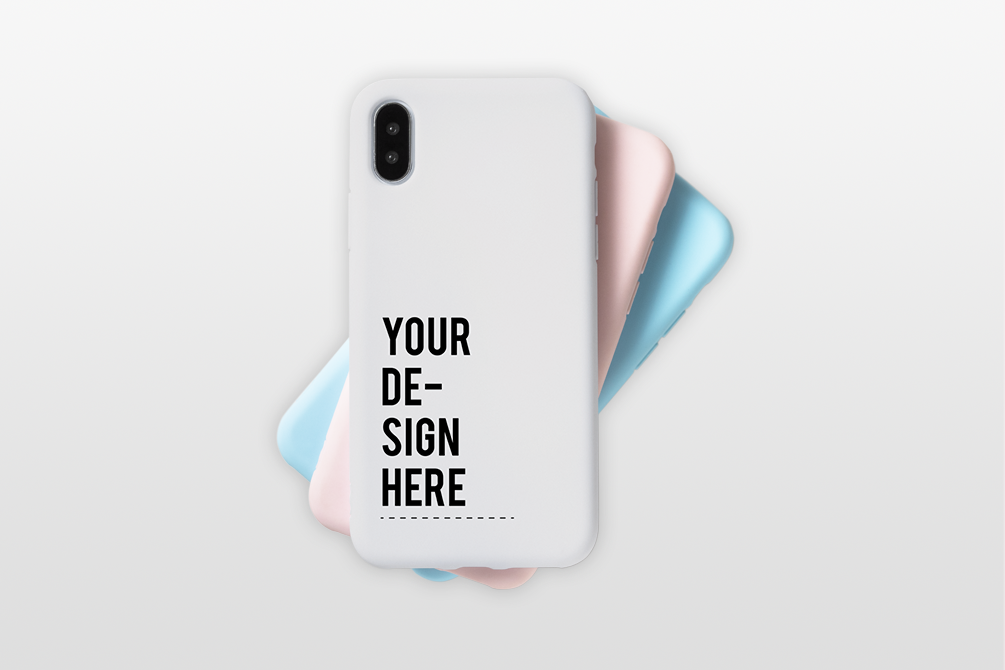Anybody can start a business today. All you need is a great idea and the right tools.
But what if the entire business model is different from traditional B2C?
B2B marketplaces are not new, but this sector is evolving at a great speed.
Audiences’ expectations are changing; there are more niche players, new payment options, new approaches to marketing, personalized experiences, digital channels, and a lot more.
Successful businesses know this, and hence they are shaping their vision that way. For instance, Tetra Pak just recently launched their first virtual marketplace.
If they wanted, it could have built a one-stop shop, but instead, the company did a narrow launch offering only spare parts and consumables.
Narrow launch and impeccable customer experience helped them create great customer value.
For entrepreneurs like you who are wondering how to build a B2B marketplace must know that you are not just creating an online shop.
You need to address the specific requirements of B2B buyers and deliver the best online experience.
Here’s a quick summary of topics on B2B marketplace development:
- What Does B2B Marketplace Look Like & How It Works
- Identify What to Sell
- Choosing a Business Model
- Giving B2B Platform a B2C Treatment
- How to Build a Website That Wins Customer Trust and Sales
- Set Up A Printing Infrastructure
- Demand for Faster Deliveries – Choose the Right fulfillment model
- Promotional Strategies for Pre-launch
- How to Retain Clients and Acquire New Ones
How Does B2B Marketplace Look Like & How it Works
The B2B marketplace boom is just the beginning, and there are a lot of opportunities. A survey by Digital Commerce 360 found that 20% of purchasing managers spent more on marketplaces. 22% spent significantly more during the pandemic.
Businesses are not just deciding to sell on marketplaces like Amazon, but they want to build their own. Experts predict that B2B marketplaces will be the next billion-dollar eCommerce start-ups.
Even before the pandemic, B2B marketplaces were expected to generate $3.6 trillion in sales by 2024.
This suggests that the future of B2B marketplaces looks promising, and this is undoubtedly the right time to create such a platform and succeed.
Before we look into the steps of building a supplier vendor marketplace, let’s first see how a B2B marketplace works.
B2B marketplace development allows you to offer a seamless partnering platform to other businesses to come and use the platform to design, sell and fulfill the products. A marketplace consists of two stakeholders, business owners, i.e., admin, and vendors or resellers.
As a marketplace owner, you will work with retailers, resellers, independent organizations like nonprofits or schools, and even independent designers. Your end clients may or may not have an in-house fulfillment or printing infrastructure.
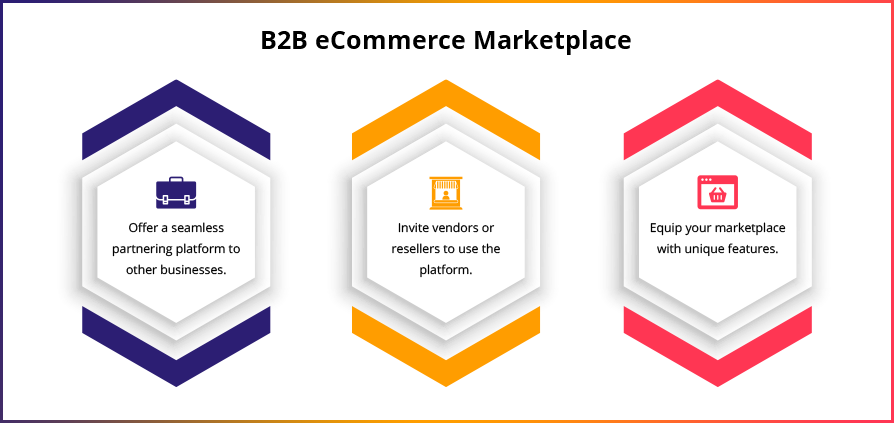
In most cases, vendors will have their products except for customers like independent designers or institutes like an NGO.
Your platform comes with a product designer tool that allows vendors to sell customized products. You can offer unique products and templates designed for your clients as per their brand identity. They can even design their own products using the tool.
Building a multi-vendor B2B marketplace comes with various benefits. Marketplace owners get a chance to create a new business or grow an already existing business in a specific market that has a growing need.
Build a B2B marketplace and start selling products with a USP of product customization
Create a Vertical Marketplace to Build a Space of Profit
Online marketplaces further fall into two types as per platform specialization – horizontal marketplace and vertical marketplaces.
The horizontal marketplace model caters to the needs of more than one industry in a diversified market. Amazon, for instance, is a horizontal marketplace. On the other hand, vertical marketplaces specialize in one market sector or category with a targeted audience.
Whether you want to start creating a B2B marketplace in a niche segment or building a horizontal model, it depends entirely on your business goals. However, the vertical market is currently gaining momentum.
To expand their business, many well-established online businesses have started building their vertical marketplaces. Many start-ups have emerged, offering their niche solutions.
Why are vertical marketplaces gaining more popularity?
The reason why vertical marketplaces are growing is that they have a well-defined target audience. Being niche-specific gives more clarity over features and functionalities, which is crucial to a marketplace’s success.
Secondly, with less-intensive competition in vertical marketplaces, businesses can easily become a dominant force in a category.
In short, niche-specific markets are beginning to bloom, and if you can do well here, there is no stopping you from leading the industry very soon.
Idea in Action
PackHelp for SMEs
Printing companies usually take large orders where end customers need thousands of units. Small businesses find it difficult to get quality products in the quantity they need.
Here is where Packhelp, a Poland-based niche marketplace, steps in. Launched in 2015, the start-up aims to offer fully-custom branded packaging in small quantities. Packhelp had an average growth in revenue of 9,077% between 2016 to 2019.
Currently, Packhelp’s platform has:
- Seven language versions
- 5,000 customers from 29 countries
- 600 orders a day.
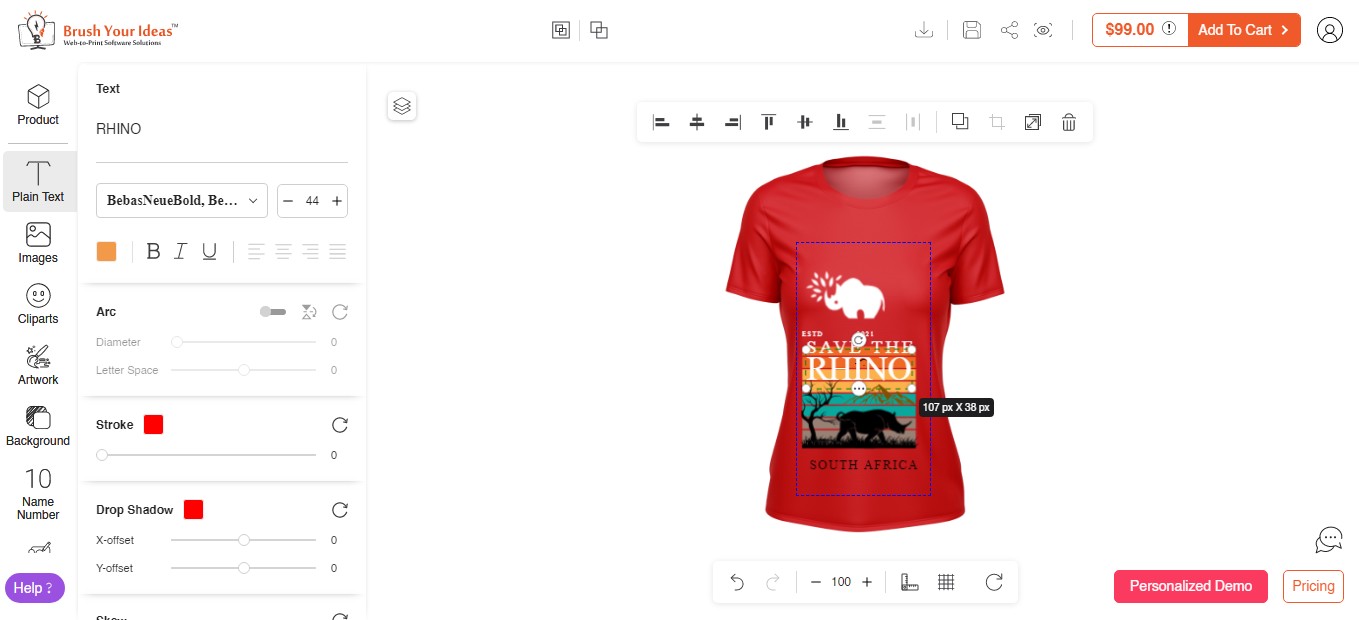
(Fully Functional and Completely Customizable Product Designer Tool By PrintXpand)
In the same way, Packhelp provides customers with custom products, you can enable product customization on your platform. Using tools like a product designer tool, your customers can create customized designs for your product.
They can browse from a huge library of images, texts, clipart, and ready templates to create personalized designs on any and every device. Explore more features of our product designer tool to find out.
Identify What to Sell
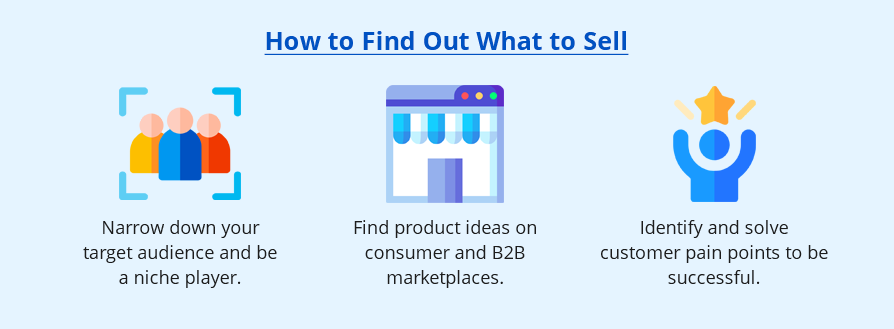
A. A Niche Player First to Become a Market Leader
Once you decide that you want to create a B2B marketplace and offer niche solutions, it’s time to figure out what you will be selling. The easiest way is to start narrowing down your target audience. Which industry do you want to cater to? Is it fashion, apparel, books, electronics, packaging, gifts, and so on?
Dig deeper. If you choose to start a business in the clothing industry, narrow it down further. What audience do you want to serve in the clothing market? Children, women, sportswear, plus size, etc.
And no, a niche is not going to limit your company’s potential. It will accelerate your chances to become a market leader. The most popular example in the narrow fashion segment is Lululemon.
The Canadian company started by targeting a specific segment – women fitness apparel for the mid-30s, high-income, health-conscious customers. Today it has a market capitalization of $53.20 Billion and has customers from all over the world.
B. Places Where You Will Find Product Ideas
Marketplaces like Amazon, Etsy, eBay are rich sources to find product ideas. Browse Amazon’s bestseller page, check the Amazon trend report, best-selling items on Etsy, eBay, etc.
Dealing with hundreds of products on different marketplaces is surely a time-consuming job. You can make use of product research tools like AMZScout.
B2B wholesale marketplaces like Alibaba are another way to get product ideas. Its huge product database is sure to help you find the right business idea.
To find business ideas, make maximum use of keywords. Most queries begin on search engines, and hence you will find product opportunities in keywords. Using tools like Keywords Everywhere, Keyword Tool, etc., you can uncover popular search terms.
C. How to Pique Potential Clients’ Interest in Your Brand
Marketplaces like Upwork wouldn’t have been launched if finding freelancers for your business was not a problem.
Finding and solving your end customers’ pain points is an effective way to get people to talk about your brand.
The example of Packhelp that we talked about earlier; why was it successful within just 5 years of launch? They addressed small businesses’ pain points of finding branded packaging in small quantities.
Similarly, Vistaprint. The print giant started with an aim to solve business owners’ challenges in finding marketing materials in less quantity and at a lower price. Look at how they have grown and expanded their business today.
Once you know what you are selling, identify how your offering can help your clients. Join B2B communities and social media groups where business-related discussions happen. You will get insights into what challenges your clients are facing.
When selling your products, always focus on benefits. Tell your prospective clients how your product fits their needs, why they should do business with you.
Start B2B eCommerce marketplace using a fully functional product designer tool that is compatible with all eCommerce platforms.
Tell us about your business requirements, and our experts will conduct a personalized product demo.
Choosing a Business Model
Before you start with B2B marketplace development, you need to choose a revenue model. There are two most widely spread business models of B2B marketplaces:
1. Subscription-based Model
In today’s rapidly changing eCommerce environment, subscription-based businesses are the trending business model.
Here, your online business-to-business marketplace does not charge for each transaction fee; instead, you charge monthly or yearly payments for a certain set of features.
The subscription-based model is a part of the freemium model, where basic functionality is free. But users have to pay a recurring fee to enjoy advanced features.
Idea in Action
Joor is a global fashion marketplace. It connects top brands with retailers. For retailers, the marketplace is free. It charges brands a subscription fee (about $5,000 to $20,000 per year) based on the brand’s size and customization they need. In return, the market gives them access to tools like order tracking, shipping, lead generation, etc.
2. Commission Fee
The most popular revenue model in the online business-to-business marketplace. You can also call it a transactional model as you earn from every transaction that happens on your website.
Depending on your business plan, you can charge either percentage-based or fixed amount commissions. Some marketplaces even charge vendors or resellers a listing fee.
Idea in Action
The most popular example of this type of model is Upwork. It drives revenue via two types of sources – a service fee and a transaction fee. When an Upwork user successfully bills a client, they have to pay a service fee. Upwork also charges a transaction fee of 3% for handling and processing every transaction.
Your revenue model is not static. As your business grows, it is likely to change. A lot of B2B eCommerce marketplaces that have more vendors have an advertisement-based model. Along with fees or subscriptions, they earn from advertisements.
For example, Global Sources have two revenue streams – per trade brokerage and advertisement fee from suppliers who want to feature their products.
Giving B2B Platform a B2C Treatment
A few years ago, a customer-centric mindset was hardly a priority in the B2B space. But things are slowly changing. New-age buyers, driven by B2C experiences, are demanding the same experience for their B2B purchases.
And hence, B2B companies are starting to see value in customer experience. Here are some statistics that prove that the business-to-business marketplace landscape is changing.
- 90% Buyers start their B2B purchase journey with a search engine
- 73% Millennials are involved in B2B purchasing decisions
- 86% Decision-makers prefer self-service tools over a salesperson
- 25% Enterprises will launch AR by 2022
- 80% B2B buying decisions are based on a buyer’s direct or indirect customer experience
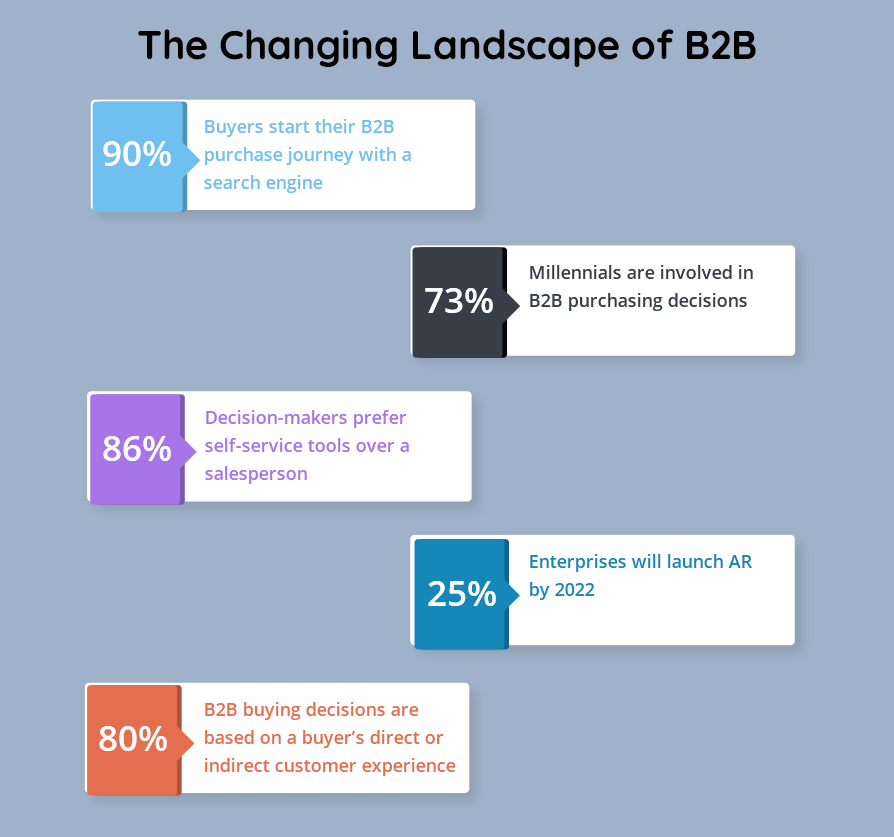
Giving the best customer experiences starts with building a well-functioning and feature-rich website. Launch your multi-vendor B2B marketplace with PrintXpand.
How to Build a Website That Wins Customer Trust and Sales
The nature of online business to business marketplace is all about building trust and loyal customers who will do repeat business. To gain trust and attract users, focusing on every touchpoint from a seamless website experience to post-purchase interactions becomes essential. This section talks all about what you need to build a multi-vendor B2B marketplace.
A. Create a Unique Brand Identity
Brand identity includes what your brand says, what your values are, how you communicate your product, and what you want people to feel when they interact with it. Essentially, your brand identity is the personality of your business and a promise to your customers. – HubSpot
Once you have your company’s vision, mission, value proposition, etc., in place, it’s time to bring your brand to life using design.
For that, you will need to have a unique and impressive logo, templates for things like emails, business cards, etc., packaging designs, and so on.
You also want to ensure a seamless user experience on your website. The key to delivering an exceptional experience is simplicity. Have a clean layout with two or three color schemes and plenty of white space.
Secondly, try and get rid of unnecessary disruptions like auto-play videos, pop-ups, etc. Other things like effortless navigation and clear and concise copy help in improving the user experience.
B. What Makes Your End Customers Trust Your Website?
The value of transactions that happen on your B2B eCommerce marketplace is worth thousands of dollars. And no vendor wants to take any risk. Hence, it is crucial to winning your customers’ trust. It is the biggest factor that ensures new leads, conversions, and loyal customers.
What often hurts trust on a business to business marketplace is no contact number, stock images, lack of any messaging option, etc.
The first thing you can do when you create B2B marketplace is to build a transparent and compelling homepage. Include everything about your business story, mission, how partnering with your company can be beneficial.
C. Must-have Features for B2B Marketplaces
Typically, a B2B eCommerce marketplace involves both backend configuration for admin users and vendor backend account configuration.
Backend Configuration for Admin Users
This will allow online business to business marketplace owners to access features of the eCommerce system. This will include an admin dashboard, features to manage vendor users, requests, catalog, payouts, management of payment transactions, reviews, and a lot more.
Vendor Backend Account Configuration
Based on the backend configuration, once you approve a vendor’s account, they can log into their account with the registered email and password. After login, they have access to different modules like a dashboard, catalog management, orders and payments, settings, and more.
Once the marketplace is set up from the backend, the front side will include a homepage, product listing, product detail page, vendor profile, etc.
This was a general feature overview for the B2B eCommerce marketplace. But every business is unique, and hence every requirement is different. Tell us about your project, and we will assist you in creating a marketplace of your own.
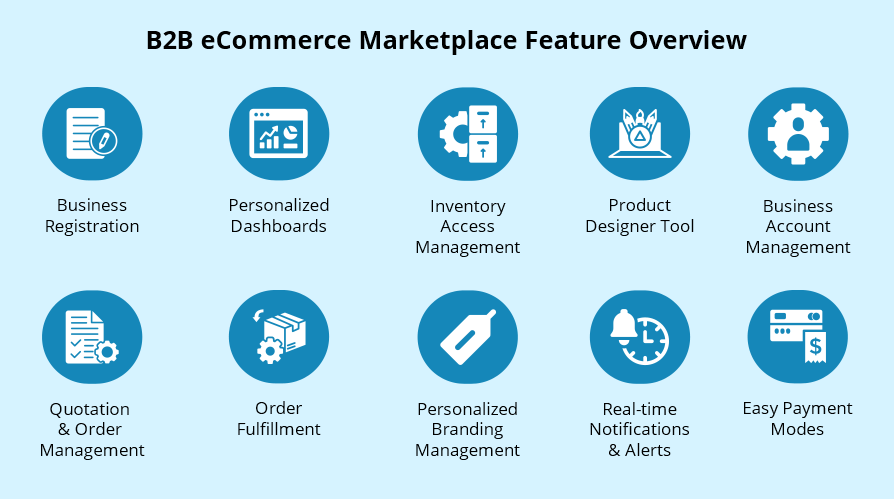
Build a feature-rich and functional B2B eCommerce Marketplace with PrintXpand
For enhanced customer experience, the following features are crucial for a B2B eCommerce marketplace.
Easy Product Comparison
Whether it’s a subscription plan or products you offer, your end customers would want to compare. Hence ensure that product comparison is easy on your website.
When comparing products, your users expect to know the main characteristics of a product on the product page (preferably in bullet points). Comparison tables are also a good way to help users find what they want.
Variety of Payment Options
B2B buyers’ expectations lead towards a more streamlined purchasing process. Payment methods, therefore, need to be more flexible. Offering multiple payment methods often leads to a higher volume of transactions and better results.
Different payment methods have different cost structures. As per your business model and location of customers, choose options that are fast and secure.
Other best practices to offer a seamless experience are creating custom pricing for specific customer segments, allowing B2B customers to buy, track, and reorder products, and more.
D. Cater to The Growing Expectation of B2B Personalization
In 1998, Amazon was just four years old and on the path to becoming a giant online empire. Dusting that year, Jeff Bezos said in an interview with the Washington Post: “If we have 4.5 million customers, we should not have one store but 4.5 million stores.”
The message is to focus on what each allows your visitor. That’s where personalized experiences come into the picture. Real-time personalization ensures that a platform or website attracts the attention of different visitors.
This is not just important for B2C businesses. B2B customers expect the same experiences that B2C customers are getting.
Reports suggest that 50% of B2B buyers identify personalization as a key feature when searching online. They are even willing to spend 48% more when experiences are personalized.
How do you start personalizing your website for maximum impact? Here are a few things to consider.
Website Personalization
First, start by identifying segments like your potential vendor’s company size, revenue, geography, sales stage, etc. Once you identify segments, you can align messages with where they are in their buying journey.
The most basic way of web content personalization is serving personalized homepage content and recommendations. Some elements of your website that you can personalize are the homepage headline, call to action, customer testimonials, product features, and suggested blogs or other resources.
Product Customization
The success of Dell’s customization strategy has led eCommerce business owners to ensure that they customize their offerings. Not just B2C companies but B2B companies have started enabling end users to design their products using a product designer tool.
PrintXpand fulfills all the requirements of product customization using our product designer tool. Our fully functional tool lets your end customers create customized and print-ready files.
It includes all the essential features you need in a designer tool like clipart library, customizable text, font manager, image upload, filters and effects, and so on.
Apart from these, our tool offers some outstanding features like:
Artwork Manager – You can create and assign artworks to single/multiple products and thus create ready-to-sell designs.
Industry Layout Manager – A specific design layout that enables businesses in every industry like apparel, packaging, etc., to manage layouts.
Custom-templates – Create ready-to-use templates for different products and add them to the designer tool.
Live Pricing System – Give your customers a complete bifurcation of design customization price on the tool itself while designing.
Quote Manager – An add-on that makes it easier for your customers to find their favorite quotes.
(T-shirt Designer Tool by PrintXpand)
Know What Features Your B2B Multi Vendor Store Requires
Set Up a Printing Infrastructure
Once you have your products ready, you need to figure out how you are going to print them. This step starts with choosing a printing method. There are various printing methods available.
The most commonly used types of printing include offset lithography, flexography, digital printing, large format, screen printing, and 3D printing.
Once you choose a printing method based on your requirements, the next step is to manage to print. You can either set up in-house printing infrastructure or partner with a printing vendor.
Demand for Faster Deliveries – Choose the Right fulfillment model
Your end customers are always in a hurry. They expect you to provide fast shipping options. To cater to customer expectations, you need to have your fulfillment model in place.
eCommerce fulfillment includes all operations, including storage, inventory management, warehouse management, order picking and packaging, shipping, and return management.
A. Types of eCommerce Fulfillment Model
Based on your business type, size, and requirements, you can choose from the three most popular fulfillment models.
1. Self Fulfilment
As the name suggests, here, you manage all aspects from storage to shipping. For starters, it is feasible and pocket-friendly. But not sustainable as your business grows. You will need to invest in additional storage space to manage all operations.
If you choose to have a self-fulfillment model, two things are important to note – (a) a good packaging design and (b) negotiated shipping rates with FedEx, UPS, and/or USPS.
2. Third-party Fulfilment Services
Outsourcing fulfillment operations to a 3rd party saves you an upfront investment required for a warehouse and workforce to pack and ship orders. Your fulfillment provider will complete all operations within their fulfillment centers.
Having professionals who manage everything will enable you to focus more on enhancing their product and getting more customers.
3. Dropshipping
In this model, you never hold any inventory. Your wholesaler or manufacturer directly ships products to your customers. Dropshipping typically works this way:
When a customer orders a product from your platform, you pass that order information to the drop shipper. Then they pack and ship the goods directly to your customers. They usually charge a wholesale plus drop shipping fee.
Dropshipping allows you to test new products or ideas.
Promotional Strategies for Pre-launch
Promoting a B2B multi vendor marketplace before its official launch is more challenging than ever. Here are five best practices to promote your B2B eCommerce marketplace:
A. Send a Sign-up Message Using a Landing Page
To capture the interest of potential users, send a sign-up message that works as a pre-launch teaser. A landing page will allow you to make the most of your sign-up campaign.
Include as much information as you can on your pre-launch landing page. Articulate your brand’s vision and plans, and most importantly, talk about what solution your business offers to solve end user’s pain points.
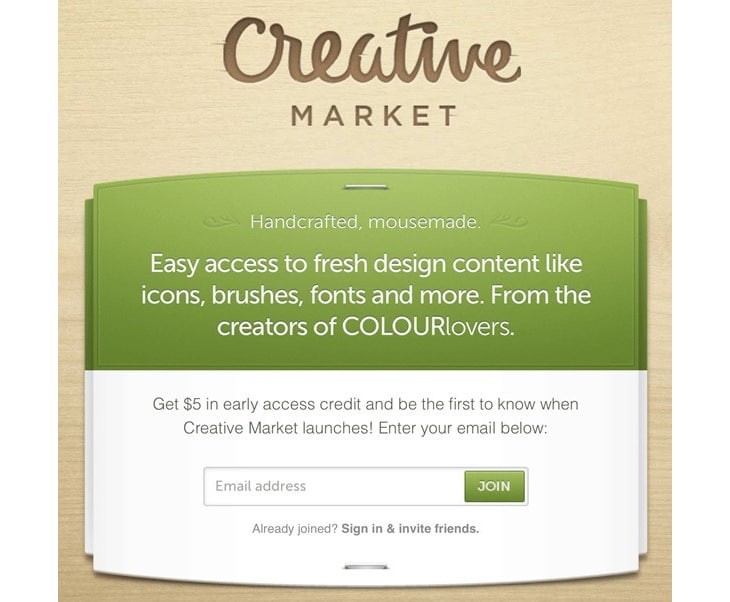
(Creative Market’s Successful Landing Page with an Attractive Offer to Encourage a Sign-up)
A landing page aims to help you collect emails of potential customers. This information helps you in creating effective marketing campaigns later. To encourage users to share their email, offer some incentive in return.
B. Create a Sneak Peek Video
Video content is the most popular trend in marketing. It’s the best way to convey information and improve engagement. As a part of your pre-launch promotion plan, you can convey the benefits of your marketplace platform using a short explainer video.
This doesn’t mean you just list the benefits. Start the video with a problem, introduce your marketplace as a solution, and end with a call to action.
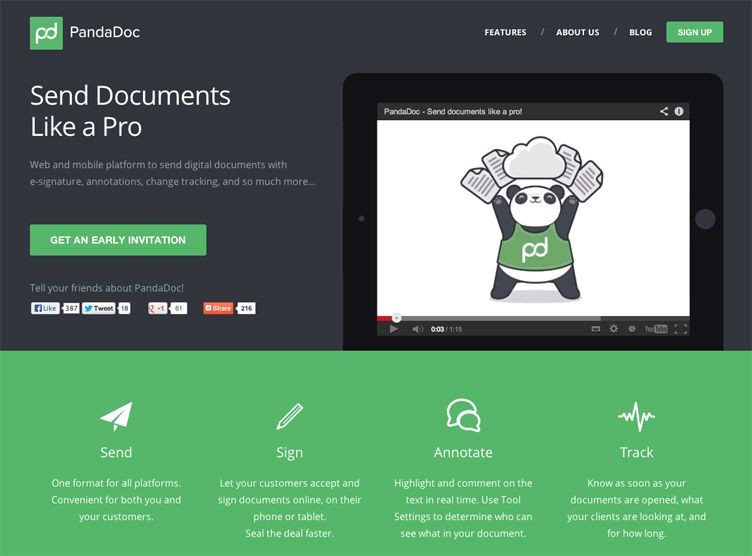
(Panda Doc Added a Video on Its Landing Page)
Share videos on social media, or you could even include a video on the landing page or even in your emails. That helps in increasing conversion rates.
How to Retain Clients and Acquire New Ones
As mentioned before, business on a B2B eCommerce marketplace is all about nurturing customers as they will bring repeat business. This section discusses a combination of strategies to retain existing customers and find new ones.
A. Nurture Loyal Customers with Loyalty Programs
Loyal customers are the most valuable to your business. They are more likely to recommend your brand to others. Rewarding your clients improves retention, increases customer referrals, increases customer lifetime value, and more.
As a part of a loyalty program, you can provide transaction-based discounts. Here, you can offer an exclusive discount that your clients can apply to future purchases. You can even run a referral software where you reward your existing customers for inviting other businesses.
For best results, segment your customer base, and target each segment with personalized and value-driven loyalty programs.
B. Prioritize Reviews and Testimonials
The more reviews you have, the more recognition and conversions you make. According to reports by Dimension research, 90% of consumers say positive reviews impact their purchasing decisions.
To get reviews for your B2B business, the first thing you can do is reach out directly to existing customers using email, call, or message. This will help you get customer feedback. Encourage customers to leave a review on Google by giving some incentives.
Your website is a great source for generating reviews. You could even create a separate page on your website.
C. Have a Strong SEO Strategy
In B2B, your target market is not a broad demographic group. Instead, it involves a small group of decision-makers at a company.
Hence, the first step in creating a successful SEO Strategy is to know who you are targeting. Is it someone in charge of the inventory? Or is it the business owner?
Create a persona for your target audience, and based on that persona, figure out how they search for what you sell.
User intent becomes extremely important for keyword research. Instead of just thinking about specific keyword targets, spend more time knowing why your audience is searching for what they are searching for.
A typical marketing strategy for a B2B multi-vendor marketplace is different from the way B2C brands market to end customers. Instead of broadcast commercials, and celebrity endorsements, what matters more is website performance, referral marketing, personal outreach, emails, etc.
Create a conversion-focused marketing plan with our marketing services. Take your marketplace in front of buyers who are looking for what you sell.
Build a Supplier Vendor Market with Us
B2B eCommerce carries huge profitability potential. To create B2B marketplace in a niche segment, building a user-friendly and feature-rich website, and delivering exceptional customer experiences is crucial to success. It will help you in creating loyal partnerships that ensure growth.
PrintXpand is a complete web-to-print solution for businesses in the printing as well as eCommerce industry. Our flagship product – Product Designer Tool, aims to make customization extremely easy for end-users. Compatible with all eCommerce platforms, our tool is easily customizable as per business logic. Our clients around the globe enjoy better engagement, user experience, and sales.
For entrepreneurs who are new to the concept of selling online, we have a Web-to-Print Storefront solution where you get a complete eCommerce store equipped with all functionalities plus a designer tool.
Additionally, to assist businesses in streamlining their operations, we offer solutions like print job manager, order management, inventory management, etc. Our marketing services are conversion-focused and aim to help businesses promote their online store and reach the right audience.
Build, sustain, and grow your marketplace with a reliable tech team.
All product and company names are trademarks™, registered® or copyright© trademarks of their respective holders. Use of them does not imply any affiliation with or endorsement by them.
